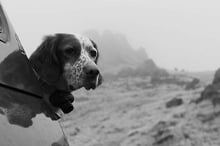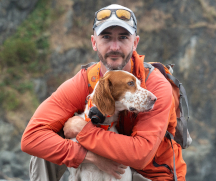No products in the cart.
In Chukar Country

An Investment in Future Hunts
Story and Photos by Marc Fryt
My English setter works a craggy gully in the southwestern Idaho part of the Owyhee Mountains, weaving easily among the rocks, his tail wagging in enjoyment of the hunt. After a full season, Windsor’s nose is attuned and I trust it. The fog is beginning to thicken, so I hoof it to catch up. My boot slips and my arm straightens out as I fall toward the canyon.
I grab at a chunk of earth and skid to a stop. The left side of my body and hand are streaked with mud. I curse, wipe the mud from my glove, adjust my game vest, and scan for the dog. He’s now birdy [on the scent of game] and driving back uphill. I grumble but follow him.
The cliffs do make it dangerous to hunt chukar in the fog but even when we approached this canyon earlier in the day and I began slipping through the mud, I didn’t dwell on the cloudy conditions, because chukar hunting comes with plenty of hazards. Besides, it was near the end of the season and I wanted to be out in the country.
Chukar live in lofty areas that resemble their native mountainous homes of Afghanistan and Pakistan. They inhabit the rough-edged beauty of places like the Owyhees, whose steep canyonsides are broken up by rock outcroppings and scree fields, on ground studded with tufts of grass and basalt rubble, where the few trees and bushes are marooned in draws and valleys.
To hunt chukar, you have to hike to disheartening elevations, because the birds like to escape uphill by flight. The common hunting strategy is to climb high and shoot from above. As my dog and I begin our upward slog, I’m dressed lightly, in obedience to the saying, “Be bold, start cold.” I’ll get warm soon enough.
The ascent reminds me of the unfortunately necessary and repetitive part of mountaineering that I’ve never enjoyed: step, step, pause (head down), breathe, step, step, pause (head down), breathe. But there’s a difference: alpine climbing, which is tediously slow, is often done under headlamps that restrict your view to a slim circle of light, and even though you’re on a mountainside tied into a rope team, it’s an oddly isolating, claustrophobic experience. Conversely, climbing for chukar is usually done in daylight.
This content is available for purchase. Please select from available options.
Purchase Only
Purchase Only

